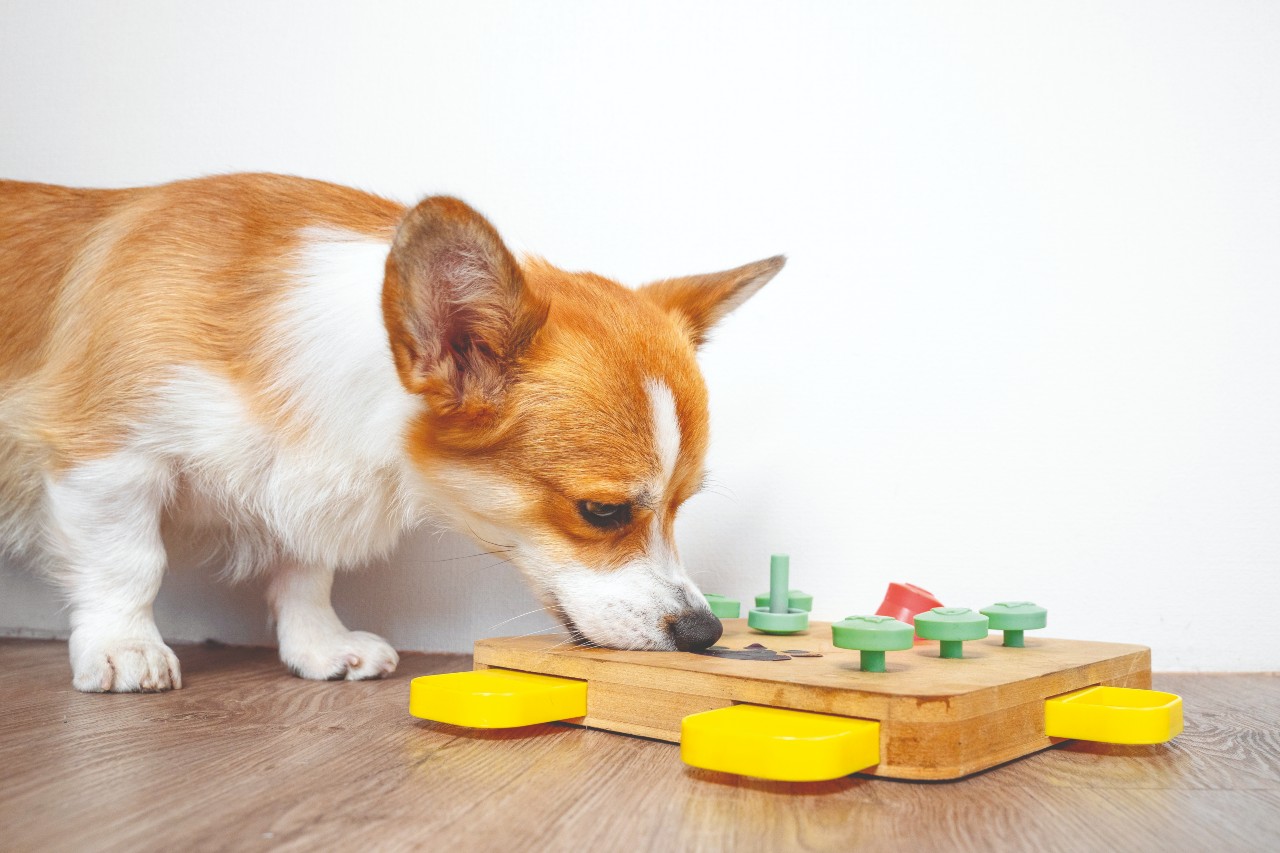We look at how to help drive dog toy sales
Dog owners need to purchase so many different products to help them care for their canine companions. Of all the things dog lovers can potentially buy from your store, nothing should be as fun as toys!
Play time is an essential part of caring for our pets. It may sound frivolous but it is really valuable for a dog’s health and well-being, just think about the things you enjoy doing to relax. And of course, that can include us playing with our pets. Toys are key to that as they are the source of excitement and provide the basis of the type of play that will be enjoyed. The role and benefits of dog toys are hugely diverse:
Retailers’ view: Key selling points of dog toys
l Exercise – toys provide an outlet for physical exercise, helping keep them in shape
l Mental stimulation – the right toys will give your dog a mental workout, which can be even more tiring than chasing after toys!
l Reward – not all dogs are food motivated (honest, it’s true) but playing with their favourite toy can be the perfect motivator when it comes to training
l Distraction – providing a toy can be handy at providing a distraction. For example, if a dog is doing an unwanted behaviour, providing a toy as an alternative can move dogs away from the behaviour or even prevent it
l Bonding – enjoying playing together is a great way for to bond with your dog
l Reduces stress – play with toys can release hormones which reduce stress
l Natural behaviours – toys can be a great outlet for natural behaviours such as chewing, sniffing, and running
l Dental health – some toys help to clean dogs’ teeth
l Solo play – when you need to leave your dog alone, leaving a toy can be a great way to occupy them
Retailers’ view: Impulse purchase
Dog toys are often an impulse buy. They are not bought on a regular basis in the same way dog food is. Owners may buy new toys if their dog’s old ones are looking a bit tired. On the other hand, there is no limit to how many toys an owner may want to provide. If something catches their eye and they think their dog would enjoy it, they might just put it in the basket!
This is where promoting the selling points of toys can really connect with customers. Highlighting the different uses of toys can bring them to the attention of owners.
For example, you might set up a display for toys that are good for solo play to help stave off boredom for dogs who are home alone. An owner might purchase one of these because it helps solve a problem. That problem might be that they worry about their dog being left or maybe their dog is using their energy for destructive purposes. Or you could promote the dental benefits of chew toys. It could be a good idea to promote treat-dispensing toys to customers who are buying treats, explaining that making the dog work for it can make the treats even more rewarding.
The Idea is that toys can connect with buyers’ impulses in different ways. Toys can help solve problems, provide health benefits, or just be jolly good fun! Tap into this and sales are sure to rise.

The types of toys you can offer
Chew toys – chewing is a natural behaviour for dogs that brings pleasure, reduces stress, and can help clean teeth.
Benefits:
l Helps soothe teething pain for puppies
l Satisfies the natural instinct
l Can prevent damage to household items by directing dogs to something they’re allowed to chew
l Can help to reduce plaque and tartar build-up
l Can provide sustained, solo play, reducing boredom and providing stimulation
Puzzle toys – toys which dogs have to work out to receive a treat can be so rewarding for dogs. They tap into dogs’ ancestral instinct of having to hunt for their food. It gives them a mental workout and the high of making the ‘catch’ when the food comes out.
Benefits:
l Stimulates mental activity
l Slows down fast eaters when used as treat-dispensing toys. It can be a good idea to feed some of their dinner through puzzle feeders
l Can reduce boredom and destructive behaviour, particularly when left alone
l They can be increased in difficulty as your dog gets good at solving them
Plush toys – the good old soft toy is still as popular as ever with dogs enjoying the comfort of carrying them around.
Benefits:
l Provides comfort and security, especially for puppies and anxious dogs
l Satisfies a dog’s natural instinct to carry or shake prey
l Available in a variety of shapes, sizes,
and textures
l Ones with squeakers can be popular for added excitement and games together
l They have wide appeal
Rope toys – these can be great for tug of war or for dogs to have a good chew on.
Benefits:
l Encourages interactive play such as tug of war
l Can help clean teeth and gums through natural chewing action
l Chewing releases endorphins
Fetch toys – fetch toys are still one of the most popular toys in the dog market. From launchers and frisbees to the simple tennis ball, retrieve toys are a key offering. The market has got an extensive range with brands pushing the boundary to create better toys, including glow in the dark options, gun-style launchers, and toys which bounce unpredictably.
Benefits:
l Provides excellent physical exercise
l Strengthens the bond between dog
and owner, giving opportunities to
practice recall and get your dog checking
in with you
l Encourages natural retrieving instincts
Water toys – many dogs enjoy splashing around and, with doggy pools becoming a more accessible facility for owners, water toys are growing in popularity.
Benefits:
l Designed to float for water-based play
l Ideal for dogs that enjoy swimming
l Can enhance exercise and social playtime at the beach or lake
l Can be used with paddling pools in
the garden
l These toys can provide a novelty factor as they are not used all the time
Squeaky toys – enduringly popular, squeaky toys are great for heightening the senses and getting the excitement flowing. Ideal for play together, some dogs enjoy them solo, too, if they can bite to set the squeaker off.
Benefits:
l Taps into a dog’s natural prey drive
l Opens the auditory sense for added excitement
l Can encourage independent play
l Squeakers can come in different styles of toy, including plush and rubber toys
l Some manufacturers are now producing toys that have the ability to turn the squeaker off
Dental toys – concerns around pet dental health is growing and providing solutions that require little effort are popular with shoppers
Benefits:
l Promotes oral health by reducing tartar and plaque
l Freshens breath with special materials and designs
Interactive toys – battery-operated toys that use motion sensors to kick into life or can be set to spark into life at a certain time, can provide hours of fun. These can be really helpful for when dogs are home alone.
Benefits:
l The unpredictable movement can be really exciting for dogs
l Can be a boredom buster for dogs
left alone
l Good for solo play
Eco-friendly toys – with sustainability becoming a priority for many consumers, there are a host of green dog toys hitting the market. From recycled plastic bottles to rubbish cleaned from the ocean, a variety of materials can be used.
Benefits:
l Made from sustainable, non-toxic materials
l Safe for pets and contribute to ethical consumer choices
l Good variety of products and customers don’t have to accept a drop in quality of
the toys

Retailers’ view: Key times for toys
While toys are all-year-round sellers, there are certain times that can be key for driving toy sales:
l When someone gets a new dog – this is likely one of the only times a consumer is looking to buy a host of dog toys. They want to provide their new puppy or dog with a range of different options that
will keep them happy and help them settle into their new home. You can
tap into this by having a designated puppy toy
l Christmas – toys are always great sellers at Christmas as owners want their canine companions to be part of the festivities. It can be worthwhile getting seasonal toys in to really tap into that Christmas spirit
l Birthdays – more owners are celebrating their four-legged companion’s birthday or ‘gotcha day’ to mark when the dog became part of the family. Promoting the idea of getting a toy for your dog’s birthday on your social media can add extra sales
l Seasonal changes – when the weather turns, different types of toys can become more appropriate. So, toys for indoor play or glow in the dark options during the winter or more outdoor and water toys for the warmer months. Think
about how your offering can tap into
the seasons
l When owners take their dogs on holiday – taking your dog away on holiday can be a time when owners buy toys as the’re in a mindset of thinking ‘What does my dog need?’ Toys will undoubtedly be on that list and getting a new toy can add to the excitement of an impending getaway
Retailers’ view: Social media
Many pet shops are getting into the habit of sharing videos of dogs playing with toys that have been bought from their store, on their social media. Using your current customers as ambassadors is a great way to promote your toy ranges and gives them a seal of approval. It’s also an easy way to generate compelling content. Ask shoppers if they could share a video and tag in your account. Most owners will love that you’re sharing a cute video of their dog and you get easy promotion!
Retailers’ view: Sizes, shapes and breeds
One thing to consider about your selection of toys is how different dogs might need, or prefer, certain types of toys. Size is an obvious one. Toys need to be able to fit a dog’s mouth, whether they are dainty or giant breeds. There’s
a safety element, too, you don’t want them too small so that dogs could swallow them.
There are also preferences to think about. Different breeds have hardwired behaviours and instincts. For example, a retriever may love a plush toy it can carry in its mouth or a fetch toy as if it was retrieving game. Super-intelligent dogs, such as Border Collies, may find the easy-level puzzle feeders boring as they’re not a challenge. Encourage owners to watch closely to see what their dogs prefer.

